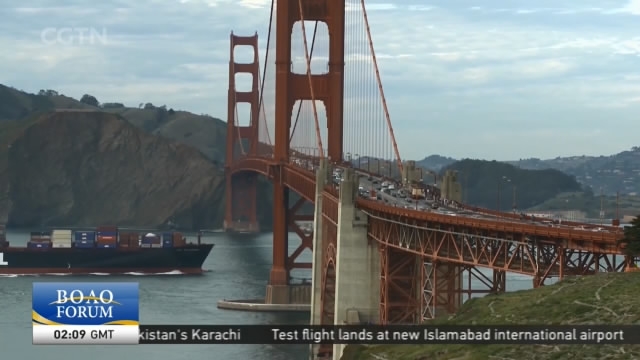
10:32, 08-Apr-2018
San Francisco Bay Area: Both bay areas could benefit from more direct economic links

MARK NIU SAN FRANCISCO "The San Francisco Bay Area is composed of the city of San Francisco, San Francisco Bay behind me, the North Bay which contains many famous wine vineyards, the East Bay with cities like Oakland and Berkeley, and the South Bay which contains the famous Silicon Valley. Altogether, it's less than eight million people, only about 11% of the population of China's 'Greater Bay Area'. But, when you think of the term 'Bay Area', it's hard not to think of that symbol right behind me and all this place stands for."
From the Golden Gate Bridge to Fisherman's Wharf to the world's last manually operated cable car system, the San Francisco Bay Area has managed to retain its historic flavor, while achieving an economic growth rate that's three times the U.S. national average.
DARLENE CHIU BRYANT EXECUTIVE DIRECTOR, CHINASF "Everybody comes here to make money. That's what San Francisco that's how it was formed. The gold rush and all of a sudden bong you have a city."
Darlene Chiu Bryant heads 'ChinaSF'-an initiative to foster investment and economic growth between the San Francisco Bay Area and China.
DARLENE CHIU BRYANT EXECUTIVE DIRECTOR, CHINASF "I think it's really different in that first of all, politically speaking - and even from a governance perspective - in China, in particular, it's really top-down heavy. Whereas, here in the U.S., we're like bottom-up. Whatever happens in the city, it's because entrepreneurs, innovators want it to happen and the government is here to support them."
Perhaps, nowhere is that bottom-up approach more apparent than in Silicon Valley-where Apple, Google and Facebook all built multi-billion dollar companies based on disrupting tradition.
MING ZHOU BUSINESS PROFESSOR, SAN JOSE STATE UNIVERSITY "The anti-hierarchy, anti-establishment culture, is really deep-rooted in the Silicon Valley geographic area. I'm from China, so our traditional culture is more of a hierarchy, respect to power, which is not necessarily bad. But, in terms of innovation, cultural environment, I think that can be a barrier-or at least a resistance for the free sparkling of all the innovations."
Zhou says China's Greater Bay Area has unprecedented potential, calling Shenzhen the world's capital for manufacturing. But he also says the region could learn by studying the environment created by Silicon Valley's most prestigious university-Stanford.
MING ZHOU BUSINESS PROFESSOR, SAN JOSE STATE UNIVERSITY "They set up this club for sharing technology, software developments. At the time, there were two members that were active members of this club-Steve Jobs and Steve Wozniak. So, you can see this deep trust, all these entrepreneurs shared with other people that really fostered this collaboration and the free flow of ideas."
More than a third of San Francisco's population is of Asian descent, leading some experts to believe both bay areas could benefit from more direct economic links with each other.
DARLENE CHIU BRYANT EXECUTIVE DIRECTOR, CHINASF "Wouldn't it be cool if we could do a bay to bay initiative where in so many ways we are similar, have so many cultural ties, and that even from an economic perspective we are so very similar. Are there ways where we can partner?"
Chiu Bryant says it's these similarities that could make the 'greater bay areas' gateways for both Asia and the West. Mark Niu, CGTN, San Francisco.

SITEMAP
Copyright © 2018 CGTN. Beijing ICP prepared NO.16065310-3
Copyright © 2018 CGTN. Beijing ICP prepared NO.16065310-3